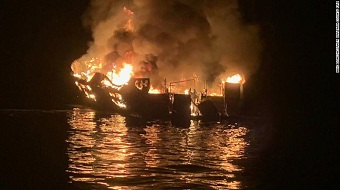The U.S. Coast Guard has announced new fire safety rules for small boats more than two years after the deadliest maritime disaster in modern California history, and more than a year after Congress passed legislation requiring it to do so.
The interim rules, published Dec. 27 and set to go into effect March 28, require boat operators to install fire detection systems and fire extinguishers, ensure proper escape routes are available, and develop procedures for handling potentially dangerous items like rechargeable batteries, among other requirements.
They come in response to the 2019 Labor Day fire aboard the Conception dive boat off the Channel Islands, which left 33 passengers and one crew member dead and exposed serious flaws in boat safety, later detailed by a series of Times reports and an investigation by the National Transportation Safety Board.
The new rules were expected after Congress mandated in December 2020 that the Coast Guard review its regulations for small passenger vessels. The legislation, part of the National Defense Authorization Act, directed the Homeland Security secretary to order fire safety regulations for covered small passenger vessels with overnight accommodations, excluding fishing boats and ferries.
“It is a good thing for safety and I think it will help save lives, and that is what all the families want here,” said Maggie Strom of Memphis, Tenn., whose husband, Ted Strom, died on the Conception. In the wake of the Conception tragedy, the victims’ families banded together to help push forward reforms they believed would avoid a repeat. The group Advocacy 34 has continued to push for changes.
Under the new rules, boat operators will have to:
• Install interconnected fire detection systems in all spaces where passengers and crew have routine access, including dining areas, sleeping quarters and lounges.
• Install portable fire extinguishers on all existing vessels so that they meet the requirements in place for new vessels.
• Develop safe handling procedures for the operation and storage of potentially hazardous items like rechargeable batteries.
• Develop crew firefighting and emergency egress training.
• Have two unobstructed means of escape that are not located directly above, or dependent on, a berth.








